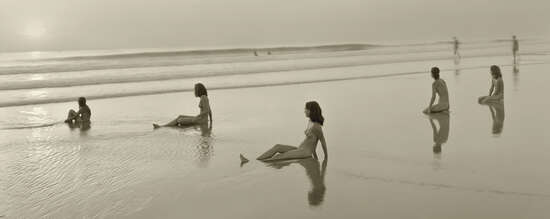Jock Sturges

In the realm of photography, few names evoke as much controversy and admiration as that of Jock Sturges. Renowned for his candid and intimate portraits of nude adolescents and families, Sturges has ignited debates about the boundaries of art, privacy, and exploitation. Through his lens, he offers a unique perspective on the human form, intertwining themes of innocence, vulnerability, and beauty. This article delves into the life and work of Jock Sturges, examining the intricacies of his approach and the impact of his controversial yet captivating imagery.
Early Life and Influences:
Born in New York City in 1947, Jock Sturges developed an early fascination with photography. His upbringing in a bohemian environment surrounded by artists and intellectuals profoundly influenced his artistic sensibilities. Sturges studied at the prestigious Marlboro College and later pursued photography at the Parsons School of Design in New York City. It was during this formative period that he honed his craft and began exploring the themes that would define his oeuvre.
In the 1970s, Sturges traveled to France, where he encountered the works of renowned photographers such as Henri Cartier-Bresson and Diane Arbus. Their emphasis on capturing raw human emotions and the fleeting moments of everyday life left an indelible mark on Sturges, shaping his artistic vision. Inspired by their approach, he embarked on a lifelong quest to capture the essence of human experience through his photography.
The Exploration of Innocence:
Central to Sturges’ body of work is his exploration of innocence and vulnerability, particularly in the form of adolescent nudity. Critics argue that his images blur the line between art and exploitation, raising ethical concerns about the portrayal of underage subjects in a state of undress. However, Sturges vehemently defends his work, emphasizing the importance of trust and consent in his interactions with his subjects.
For Sturges, the nude form represents a celebration of natural beauty and the purity of human expression. His photographs eschew overt sexualization, instead focusing on the unguarded moments of intimacy and self-discovery. Through his lens, Sturges seeks to challenge societal taboos surrounding nudity and confront viewers with the raw authenticity of the human body.
In many of his images, Sturges captures his subjects in idyllic natural settings, emphasizing their connection to the environment and the passage of time. His compositions often exude a sense of serenity and tranquility, inviting viewers to contemplate the fleeting nature of youth and innocence. Despite the controversy surrounding his work, Sturges’ photographs resonate with a timeless beauty that transcends cultural boundaries.
Critique and Controversy:
Despite his artistic intentions, Sturges’ work has faced considerable backlash from critics and censorship from authorities. In 1990, his studio was raided by the FBI, and his photographs were confiscated on suspicion of child pornography. The ensuing legal battle sparked a heated debate about the boundaries of artistic freedom and the portrayal of nudity in contemporary art.
Critics accuse Sturges of exploiting his subjects under the guise of artistic expression, arguing that his photographs perpetuate harmful stereotypes and voyeuristic tendencies. However, supporters of his work contend that Sturges approaches his subjects with sensitivity and respect, establishing trusting relationships that transcend the traditional power dynamics between photographer and model.
Throughout his career, Sturges has remained steadfast in his defense of artistic freedom, insisting that his photographs serve as a reflection of the human experience rather than objects of prurient interest. Despite the controversies surrounding his work, he continues to exhibit his photographs in galleries around the world, challenging viewers to confront their preconceived notions about nudity and innocence.
Legacy and Influence:
Despite the controversies that have surrounded his work, Jock Sturges remains a highly influential figure in the world of photography. His candid portraits of nude adolescents have inspired a new generation of artists to explore themes of innocence, vulnerability, and beauty in their own work. Sturges’ unwavering commitment to his artistic vision serves as a testament to the power of photography to provoke thought, evoke emotion, and challenge societal norms.
As society continues to grapple with questions of censorship, privacy, and consent in the digital age, the work of Jock Sturges serves as a poignant reminder of the complexities inherent in the representation of the human form. Through his lens, he invites viewers to confront their own biases and prejudices, encouraging a deeper understanding of the intricacies of human experience.
Conclusion:
In a world increasingly dominated by digital imagery and mass media, the work of Jock Sturges stands as a testament to the enduring power of photography to provoke thought, evoke emotion, and challenge societal norms. Through his candid portraits of nude adolescents and families, Sturges offers a unique perspective on the human condition, inviting viewers to contemplate the beauty and vulnerability of the human form.
While his work has not been without controversy, Sturges remains unwavering in his commitment to artistic expression and the pursuit of truth through photography. Whether viewed as provocative or profound, his photographs continue to spark dialogue and debate, leaving an indelible mark on the world of contemporary art. As we navigate the complexities of the modern age, the work of Jock Sturges serves as a poignant reminder of the enduring power of art to inspire, challenge, and provoke.
